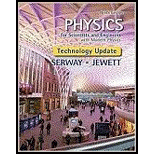
(a)
The frictional force exerted on the stopper by the nozzle.
(a)
Answer to Problem 44P
The frictional force exerted on the stopper by the nozzle is
Explanation of Solution
Given that the diameter of the hose is
Consider two points, point 1 at the free surface of the water in the tank and point 2 inside the nozzle.
Apply Bernoulli’s theorem to the given situation.
Here,
Reduce the expression (I) for
Since the pressure
The total force acting on the stopper must be zero.
Here,
Write the expression for the force exerted by water on the stopper.
Here,
Write the expression for the force exerted by air on the stopper.
Use equation (V), and (VI) in (IV) and solve for
Write the expression for the cross sectional area of the nozzle.
Here,
Use equation (III), and (VIII) in (VII).
Conclusion:
Substitute
Therefore, the frictional force exerted on the stopper by the nozzle is
(b)
The mass of water flows through the nozzle in
(b)
Answer to Problem 44P
The mass of water flows through the nozzle in
Explanation of Solution
Equation (II) gives the pressure difference at both ends of the stopper.
When the stopper is removed, the pressure on both points become atmospheric pressure
Write the expression for the mass of water leaving the nozzle.
Here,
Write the expression for the volume of water leaving the nozzle with speed
Use equation (XII) and (VIII) in (XI).
Conclusion:
Substitute
Substitute
Therefore, the mass of water flows through the nozzle in
(c)
The gauge pressure of the flowing water in the hose just behind the nozzle.
(c)
Answer to Problem 44P
The gauge pressure of the flowing water in the hose just behind the nozzle is
Explanation of Solution
Write the continuity equation for the flow of water through the hose and nozzle.
Here,
Solve equation (XIV) for
Rewrite equation (XV) in terms of the diameters of the hose and nozzle.
Rewrite equation (II) for the current situation, such that
Since the gauge pressure
Conclusion:
Substitute
Substitute
Therefore, the gauge pressure of the flowing water in the hose just behind the nozzle is
Want to see more full solutions like this?
Chapter 14 Solutions
Bundle: Physics for Scientists and Engineers with Modern Physics, Loose-leaf Version, 9th + WebAssign Printed Access Card, Multi-Term
- Hi! I need help with these calculations for part i and part k for a physics Diffraction Lab. We used a slit width 0.4 mm to measure our pattern.arrow_forwardExamine the data and % error values in Data Table 3 where the angular displacement of the simple pendulum decreased but the mass of the pendulum bob and the length of the pendulum remained constant. Describe whether or not your data shows that the period of the pendulum depends on the angular displacement of the pendulum bob, to within a reasonable percent error.arrow_forwardIn addition to the anyalysis of the graph, show mathematically that the slope of that line is 2π/√g . Using the slope of your line calculate the value of g and compare it to 9.8.arrow_forward
- An object is placed 24.1 cm to the left of a diverging lens (f = -6.51 cm). A concave mirror (f= 14.8 cm) is placed 30.2 cm to the right of the lens to form an image of the first image formed by the lens. Find the final image distance, measured relative to the mirror. (b) Is the final image real or virtual? (c) Is the final image upright or inverted with respect to the original object?arrow_forwardConcept Simulation 26.4 provides the option of exploring the ray diagram that applies to this problem. The distance between an object and its image formed by a diverging lens is 5.90 cm. The focal length of the lens is -2.60 cm. Find (a) the image distance and (b) the object distance.arrow_forwardPls help ASAParrow_forward
 Principles of Physics: A Calculus-Based TextPhysicsISBN:9781133104261Author:Raymond A. Serway, John W. JewettPublisher:Cengage Learning
Principles of Physics: A Calculus-Based TextPhysicsISBN:9781133104261Author:Raymond A. Serway, John W. JewettPublisher:Cengage Learning Physics for Scientists and Engineers: Foundations...PhysicsISBN:9781133939146Author:Katz, Debora M.Publisher:Cengage Learning
Physics for Scientists and Engineers: Foundations...PhysicsISBN:9781133939146Author:Katz, Debora M.Publisher:Cengage Learning Physics for Scientists and Engineers, Technology ...PhysicsISBN:9781305116399Author:Raymond A. Serway, John W. JewettPublisher:Cengage Learning
Physics for Scientists and Engineers, Technology ...PhysicsISBN:9781305116399Author:Raymond A. Serway, John W. JewettPublisher:Cengage Learning College PhysicsPhysicsISBN:9781938168000Author:Paul Peter Urone, Roger HinrichsPublisher:OpenStax College
College PhysicsPhysicsISBN:9781938168000Author:Paul Peter Urone, Roger HinrichsPublisher:OpenStax College Physics for Scientists and EngineersPhysicsISBN:9781337553278Author:Raymond A. Serway, John W. JewettPublisher:Cengage Learning
Physics for Scientists and EngineersPhysicsISBN:9781337553278Author:Raymond A. Serway, John W. JewettPublisher:Cengage Learning Physics for Scientists and Engineers with Modern ...PhysicsISBN:9781337553292Author:Raymond A. Serway, John W. JewettPublisher:Cengage Learning
Physics for Scientists and Engineers with Modern ...PhysicsISBN:9781337553292Author:Raymond A. Serway, John W. JewettPublisher:Cengage Learning





